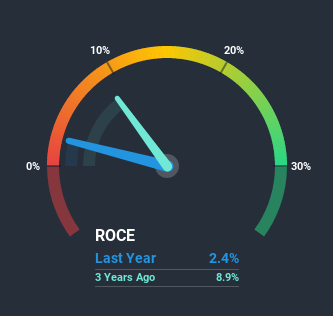- South Korea
- /
- Semiconductors
- /
- KOSE:A003160
Should We Be Excited About The Trends Of Returns At D.I (KRX:003160)?
If we want to find a potential multi-bagger, often there are underlying trends that can provide clues. In a perfect world, we'd like to see a company investing more capital into its business and ideally the returns earned from that capital are also increasing. If you see this, it typically means it's a company with a great business model and plenty of profitable reinvestment opportunities. Having said that, from a first glance at D.I (KRX:003160) we aren't jumping out of our chairs at how returns are trending, but let's have a deeper look.
Understanding Return On Capital Employed (ROCE)
If you haven't worked with ROCE before, it measures the 'return' (pre-tax profit) a company generates from capital employed in its business. Analysts use this formula to calculate it for D.I:
Return on Capital Employed = Earnings Before Interest and Tax (EBIT) ÷ (Total Assets - Current Liabilities)
0.024 = ₩4.2b ÷ (₩227b - ₩53b) (Based on the trailing twelve months to September 2020).
Therefore, D.I has an ROCE of 2.4%. In absolute terms, that's a low return and it also under-performs the Semiconductor industry average of 9.8%.
See our latest analysis for D.I

While the past is not representative of the future, it can be helpful to know how a company has performed historically, which is why we have this chart above. If you want to delve into the historical earnings, revenue and cash flow of D.I, check out these free graphs here.
What The Trend Of ROCE Can Tell Us
There are better returns on capital out there than what we're seeing at D.I. The company has employed 35% more capital in the last five years, and the returns on that capital have remained stable at 2.4%. Given the company has increased the amount of capital employed, it appears the investments that have been made simply don't provide a high return on capital.
The Bottom Line On D.I's ROCE
In conclusion, D.I has been investing more capital into the business, but returns on that capital haven't increased. Since the stock has declined 21% over the last five years, investors may not be too optimistic on this trend improving either. On the whole, we aren't too inspired by the underlying trends and we think there may be better chances of finding a multi-bagger elsewhere.
If you want to continue researching D.I, you might be interested to know about the 2 warning signs that our analysis has discovered.
While D.I isn't earning the highest return, check out this free list of companies that are earning high returns on equity with solid balance sheets.
When trading D.I or any other investment, use the platform considered by many to be the Professional's Gateway to the Worlds Market, Interactive Brokers. You get the lowest-cost* trading on stocks, options, futures, forex, bonds and funds worldwide from a single integrated account. Promoted
New: Manage All Your Stock Portfolios in One Place
We've created the ultimate portfolio companion for stock investors, and it's free.
• Connect an unlimited number of Portfolios and see your total in one currency
• Be alerted to new Warning Signs or Risks via email or mobile
• Track the Fair Value of your stocks
This article by Simply Wall St is general in nature. It does not constitute a recommendation to buy or sell any stock, and does not take account of your objectives, or your financial situation. We aim to bring you long-term focused analysis driven by fundamental data. Note that our analysis may not factor in the latest price-sensitive company announcements or qualitative material. Simply Wall St has no position in any stocks mentioned.
*Interactive Brokers Rated Lowest Cost Broker by StockBrokers.com Annual Online Review 2020
Have feedback on this article? Concerned about the content? Get in touch with us directly. Alternatively, email editorial-team (at) simplywallst.com.
About KOSE:A003160
D.I
Manufactures and supplies semiconductor inspection equipment in South Korea and internationally.
High growth potential with adequate balance sheet.
Market Insights
Community Narratives




